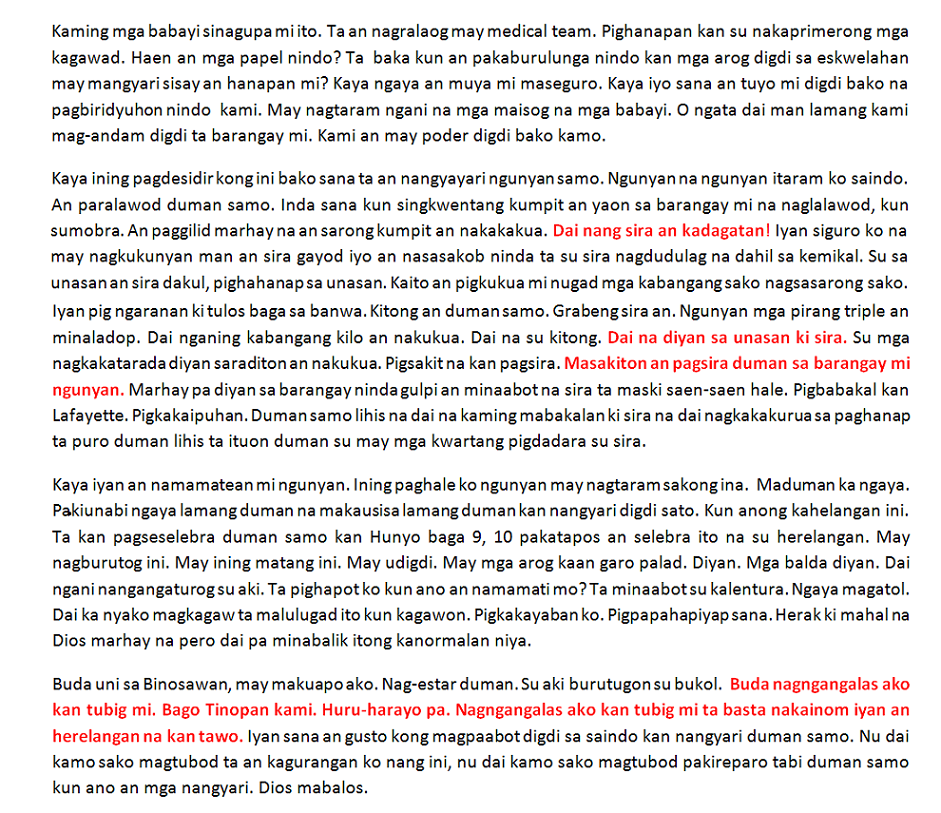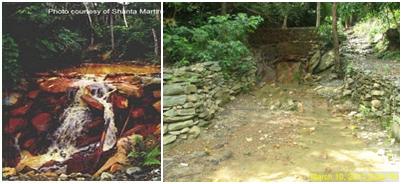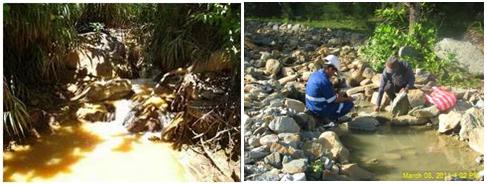or How Dominguez and Agabin have been lying to the Filipino public all this time concerning the real financial condition of Lafayette
The Act provides that 'Excluded Employees", which includes company directors and their spouses, are each restricted to a total maximum priority claim of $2,000 for unpaid wages and $1,500 for annual leave entitlements.
Amounts owed to Excluded Employees that exceed the statutory cap for wages and superannuation and annual leave/long service leave, and all payments owing in respect of retrenchment, being redundancy and payment in lieu of notice, rank for dividend with all other unsecured creditors.
5.1.13 Partly Secured Creditors
Partly secured creditors consist of convertible note holders held by the following:
- SEASAF LP - USD 10m
- VS Holdings Limited - USD 3m
- Brightyield Enterprise Limited - USD 2m
5.1.14 Ordinary Unsecured Creditors
Accounting for formal proofs of debt received to date and the Company's records, I estimate the Company's liability to unsecured creditors at $8,035,547.
This figure is subject to the receipt and adjudication of final proofs of debt from creditors.
5.1.15 Contingent Liabilities
The contingent liability refers to the amount outstanding to Leighton under a standby loan agreement and mining claims for works completed. As at the date of appointment, the outstanding debt to Leighton from RRPI was USD 4,628,206. The debt was guaranteed by the Company.
5.1.16 Omissions from Statement
Save for my previous comments regarding specific disclosures in the Statement, there are no material omissions from the directors' Statement.
5.2 Explanation for Current Financial Position
The directors' explanation for the Company's current financial position can be found at section 3.3 above.
My preliminary view is that the Company failed because of:
- Acts of God, namely two super typhoons which severely affected the mines ability to operate;
- Inadequate equipment due to delays in the delivery of vital machinery;
- Poor communication between senior and local management;
- Lack of adequate working capital.
6. Trading by Administrators
6.1 Overview
The Administrators assumed control of the Company upon appointment. It should be noted that the Administrators were only appointed to the holding company. The operational subsidiaries remained outside of formal procedures until the local management team filed for rehabilitation in the Philippines
Section 439A(4)(a) Report by Administrators
11 March 2008
Page 10
- It is not appropriate to base an assessment of whether a company can meet its liabilities as and when they fall due on the prospect that a company might trade profitably in the future.
In summary, it is a company's inability using such resources as are available to it through the use of its as-sets, or otherwise, to meet its debts as they fall due, which indicates insolvency.
8.2.2 Preliminary Determination
Set out below is a summary of my preliminary investigations and my preliminary determination as to the Company's solvency.
Review of the Company's bank facilities, including its overdraft facility, for the period June to December 2007
The Company held four accounts with the National Australia Bank Limited. I requested the accounts to be closed with the balances to be transferred to the administration account. A total of $69,663.16 was received from the accounts.
The Company did not operate an overdraft facility on any of its accounts. The Company remained in credit during the six months prior to our appointment.
Aged Payables Review
The books and records of the Company show that the amounts due to normal trade creditors were nominal $35,547 and relatively up to date. The older invoices were dated in November 2007. This does not include the $8m Australian convertible note holders.
Further, my review indicates that creditors took the following action against the Company.
Leighton issued a default notice on 17 December 2007 against RRPI in the Philippines for USD 4,628,206. As the Company guaranteed the RRPI debt to Leighton, the directors had no alternative but to place the Company into Voluntary Administration on 18 December 2007.
No other demands were received from creditors.
Finance Commitments Review
The Company had a number of Multi Option Facilities in place with various creditors. Uncertainty surrounding the Company's financial position meant that the servicing of these facilities would be questionable.
The Company had also issued over $26m in convertible notes requiring regular servicing of interest to the note holders.
The Company had a number of finance facilities with a syndicate of banks. The exposure of the Bank syndicate to the Group at appointment had risen to circa $270m.
The Bank Group and other financiers were party to the. Company's attempts to refinance prior to the appointment and as such, made no formal demands on the Company.
Working Capital and Balance Sheet Review
The Company had net current liabilities of $86,306 and net liabilities of $10.7m as at 30 November 2007. This is prior to the imposition of the Leighton default notice on the Company's
balance sheet.
Based on the above analysis, it is my preliminary view that the Company was more likely than
not insolvent from at least 17 December 2007, when it was evident that it could not pay its liabilities as and when they fell due.
Section 439A(4)(a) Report by Administrators
11 March 2008
Page 13
8.4 Insolvent Trading
8.4.1 Directors' Liability
Section 588G of the Act imposes-a positive duty upon company directors to prevent insolvent trading. If a director is found guilty of an offence in contravening Section 588G, the Court may order him or her to pay compensation to the company equal to the amount of loss or damage suffered by the creditors of the company.
The Court may also impose upon the directors' one of two types of civil penalty orders. The first can include a fine not exceeding $200,000 or an order prohibiting directors from participating in the management of a company. The second, where there is criminal intent and a conviction, a director could also be imprisoned for up to five years or fined as well.
ASIC usually applies for civil penalty orders while applications for compensation payable to the company are usually made by a liquidator, or in specified circumstances a creditor. The substantive elements of Section 588G are:
- A person must be a director of a company at a time when the company incurs a debt;
- The company must be insolvent at that time or becomes insolvent by incurring the debt;
- The director must have reasonable grounds for suspecting that the company is insolvent or would so become insolvent by incurring the debt;
Summarised below are the defences contained in Section S88H:
- The directors had reasonable grounds at the time the debt was incurred to expect the company to be solvent and would remain solvent even after the debt was incurred;
- The directors relied on another person to provide information about whether or not the company was solvent;
- The directors were ill or for some other good reason did not take part in the management of the company;
- The directors took reasonable steps to prevent the incurring of the debt.
A liquidator must form an opinion as to the date the Company became insolvent and determine the debts incurred from that date; thereby quantifying the loss to the Company.
As the Company was primarily an investment vehicle, it is my view that an insolvent trading action would not successful.
8.5 Director Duties
Based on preliminary investigations, I have not identified any breaches by the directors of their statutory or fiduciary duties.
9. Proposal for Deed of Company Arrangement (DOCA)
9.1 Statement of Proposed DOCA
It is proposed that the Company enter into a Deed of Company Arrangement with the following material provisions:
Section 439A(4)(a) Report by Administrators
11 March 2008
Page 16
- Roderick John Sutton and Peter Damien McCluskey of Ferrier Hodgson, Level 29, 600 Bourke Street , in the State of Victoria are to be the joint and several administrators of the proposed Deed of Company Arrangement ("the Deed") for the Company ("the Deed Administrators");
- The Deed Administrators will endeavour to maintain the corporate shell in order that it can be sold (subject to shareholder meetings approving the restructuring);
- The Deed Administrators will undertake a sale process and invite expressions of interest to recapitalise the corporate shell;
- Following receipt by the Deed Administrators of any monies from the sale of the corporate shell, the Deed Administrators shall be authorised to deduct from such monies any further costs and expenses incurred by the Deed Administrators (either in their capacity as Deed Administrators or when acting as Voluntary Administrators) of or incidental to getting in that amount in priority to any other creditor;
- The Deed Administrators will create a fund (''the Fund") for the payment of participating creditors' claims. The Fund shall comprise the realisation, and conversion to cash, of all assets of the Company plus any amount received from the sale of the corporate entity.
- The fund will be paid to creditors in accordance with section 556 of the Corporations Act.
- The Deed will terminate when the Fund has been disbursed in full to creditors or otherwise in accordance with schedule 8A of the Corporations Regulations;
- The Deed Administrators shall be indemnified by the Company against any liability arising from their administration of the Deed, other than such liability as may be attributable to any negligence, default, breach of duty, or breach of trust on their part;
- All creditors must accept any entitlements payable under the Deed in full satisfaction and complete discharge of all debts and claims which they have or claim to have against the Company as at the date of the appointment of the Administrators and all debts and claims within the meaning of s. 553 of the Corporations Act 2001 will be discharged by the operation of the Deed and each of them will, if called upon to do so, execute and deliver to the Company such forms of release of any such claims that is required;
- During the term of the Deed control of the Company shall remain with the Deed Administrators; and
- The remuneration of the Deed Administrators is to be approved by the creditors.The remuneration of the Administrators and their partners and staff shall be calculated with reference to the scale of rates adopted by Ferrier Hodgson for insolvency work from time to time plus GST (in accordance with the schedule attached) and the Administrators shall be entitled to be reimbursed for all expenses and other expenses incurred by them in the administration of this Deed.
9.2 Key Commercial Features
The proposed DOCA includes the following key commercial features:
A DOCA would allow for the sale of the corporate shell, which may generate a return for creditors. A sale of the corporate shell would not be available to a liquidator.
There are no expected recoveries to be made by a liquidator, resulting from unfair preference, uncommercial transactions or breaches of director duties; therefore there is no commercial benefit to creditors from this course of action.
Section 439A(4)(a) Report by Administrators
11 March 2008
Page 17
10. Creditors' Options, Dividend Estimates and Cost Estimates
Pursuant to Section 439A(4)(b) of the Act, I am required to provide creditors with a statement setting out my opinion on whether it is in the creditors' interests for the:
- Administration to end;
- Company to be wound up;
- Company to execute a DOCA.
In forming my opinion, it is necessary to consider an estimate of the dividend creditors might expect, and the likely costs, under each option.
10.1 Administration to End
Creditors may resolve that the administration should end if it appears the Company is solvent or, for some other reason, control of the Company should revert to its directors.
Based on my preliminary investigations and analysis of the Company's financial information, the Company is insolvent. There appears no valid commercial reason why control of the company should revert to its directors.
If the administration were to end, there is no mechanism controlling an orderly realisation of assets and distribution to creditors. I am unable to say what the Company might ultimately pay creditors or what costs it might incur.
Therefore, my opinion is that it is not in the creditors' interest for the administration to end. It is appropriate that the Company's affairs be dealt with under Part 5.3A of the Act under one of the options detailed in Section. 10.2 or 10.3 below.
10.2 Winding up of Company
Based upon the information in this report, where the Company is wound up, I estimate that a dividend will not be payable to any class of creditor.
10.3 Execution of Proposed DOCA
At present it is impossible to calculate the likely return to secured creditors, as the sale of the corporate shell will be sold to the highest bidder (subject to shareholder approval). At the date of this report, no expressions of interest have been received.
Due to the extent of secured creditors, there will be no dividend paid to unsecured creditors.
11. Administrators' Opinion
As stated in section 10.1 above, the option of the administration ending is clearly not viable. The only remaining options available to creditors are to wind up the Company or accept the proposed DOCA.
Although I am unable to provide a reliable estimate of the return to secured creditors under the proposed DOCA, I believe that it provides the opportunity to exceed the estimated return under a winding up of the Company.
The proposed DOCA is likely to provide a better return to creditors because:
Section 439A(4)(a) Report by Administrators
11 March 2008
Page 18
- Funds from the sale of the corporate shell under the proposed DOCA would not otherwise be available to creditors in a winding up of the Company;
- In a liquidation, recoveries from the voidable and other transactions referred to in Section 8 of this report are unlikely;
Based on the above, it is my opinion that creditors should resolve that the Company enter into the proposed DOCA.
12. Administrators' Remuneration Report
Pursuant to Section 446E of the Act, I enclose as Annexure 2 the Administrators' Remuneration Report. At the second meeting of creditors, I intend seeking approval of the remuneration set out in the remuneration report. Details of disbursements incurred are also included in the remuneration report.
13. Further Queries
I will advise creditors in writing, if practicable, of any additional matter that comes to my attention after the dispatch of this report that, in my view, is material to creditors' deliberations.
In the meantime, should creditors have any queries, please do not hesitate to contact Ian Morton.
DATED this 11th day of March 2008.
Signed
PETER MCCLUSKEY
ADMINISTRATOR
Section 439A(4)(a) Report by Administrators
11 March 2008
Page 19
Complete text of this document may be found at www.ferrierhodgson.com.au/caseprofiles/details.cfm?objectID=54































































































































